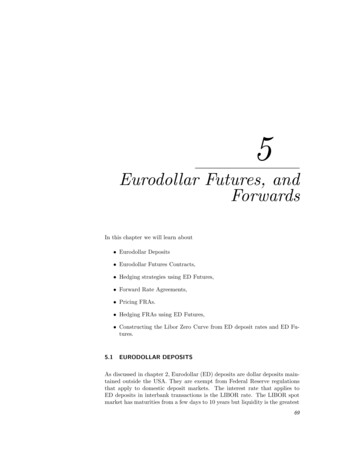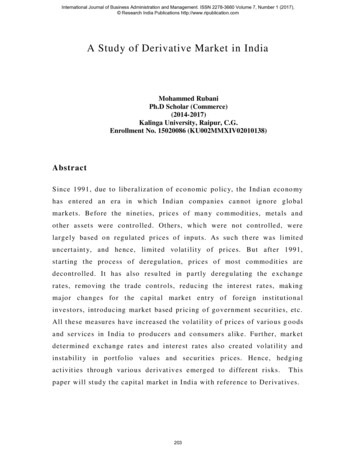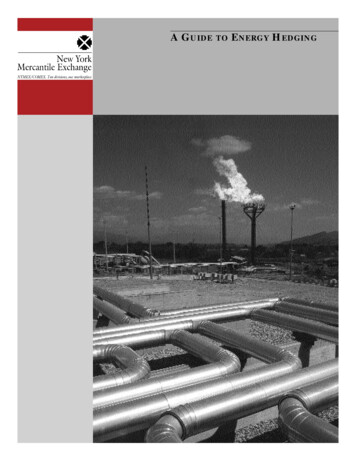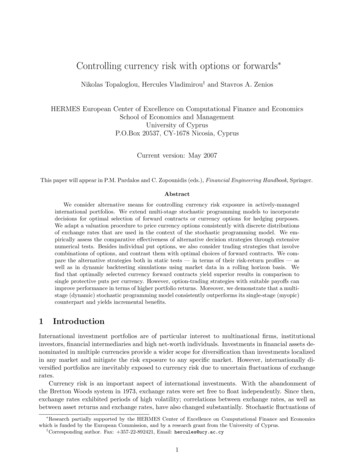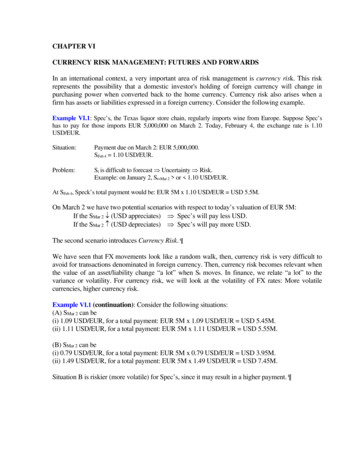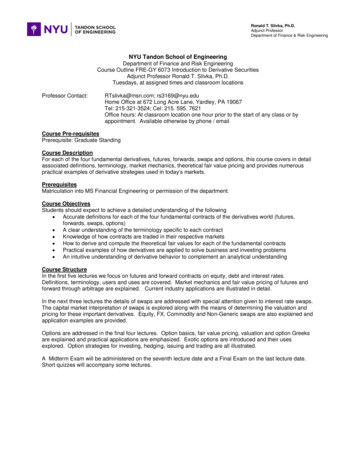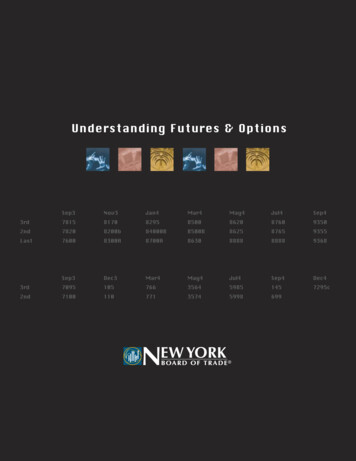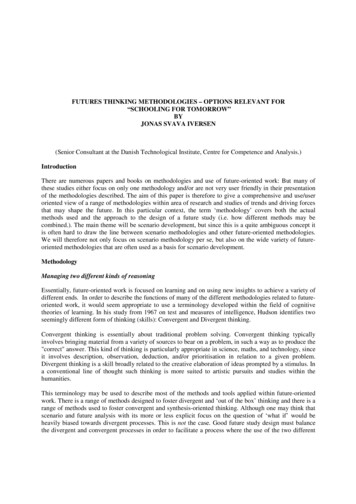
Transcription
FUTURES THINKING METHODOLOGIES – OPTIONS RELEVANT FOR“SCHOOLING FOR TOMORROW”BYJONAS SVAVA IVERSEN(Senior Consultant at the Danish Technological Institute, Centre for Competence and Analysis.)IntroductionThere are numerous papers and books on methodologies and use of future-oriented work: But many ofthese studies either focus on only one methodology and/or are not very user friendly in their presentationof the methodologies described. The aim of this paper is therefore to give a comprehensive and use/useroriented view of a range of methodologies within area of research and studies of trends and driving forcesthat may shape the future. In this particular context, the term ‘methodology’ covers both the actualmethods used and the approach to the design of a future study (i.e. how different methods may becombined.). The main theme will be scenario development, but since this is a quite ambiguous concept itis often hard to draw the line between scenario methodologies and other future-oriented methodologies.We will therefore not only focus on scenario methodology per se, but also on the wide variety of futureoriented methodologies that are often used as a basis for scenario development.MethodologyManaging two different kinds of reasoningEssentially, future-oriented work is focused on learning and on using new insights to achieve a variety ofdifferent ends. In order to describe the functions of many of the different methodologies related to futureoriented work, it would seem appropriate to use a terminology developed within the field of cognitivetheories of learning. In his study from 1967 on test and measures of intelligence, Hudson identifies twoseemingly different form of thinking (skills): Convergent and Divergent thinking.Convergent thinking is essentially about traditional problem solving. Convergent thinking typicallyinvolves bringing material from a variety of sources to bear on a problem, in such a way as to produce the"correct" answer. This kind of thinking is particularly appropriate in science, maths, and technology, sinceit involves description, observation, deduction, and/or prioritisation in relation to a given problem.Divergent thinking is a skill broadly related to the creative elaboration of ideas prompted by a stimulus. Ina conventional line of thought such thinking is more suited to artistic pursuits and studies within thehumanities.This terminology may be used to describe most of the methods and tools applied within future-orientedwork. There is a range of methods designed to foster divergent and ‘out of the box’ thinking and there is arange of methods used to foster convergent and synthesis-oriented thinking. Although one may think thatscenario and future analysis with its more or less explicit focus on the question of ‘what if’ would beheavily biased towards divergent processes. This is not the case. Good future study design must balancethe divergent and convergent processes in order to facilitate a process where the use of the two different
ways of thinking produces a result which is exploratory and creative and rooted in facts, numbers, andexplicitly stated rational assumptions.Phases and actorsThe need to base scenarios on divergent as well as convergent thinking means that a range of methods isused in the development of scenarios. Seen from a process design perspective, it is useful to think ofscenario processes as consisting of the following phases:1.2.3.4.Mapping and delineation of the subject matterIdentification of critical issues and trendsAssessments of trends (scenario creation)Use (implications and dissemination)Phase one can largely be considered as involving convergent thinking while phase two and three and fourwill involve convergent as well as divergent thinking. Generally speaking, most of the divergent processesare group processes which often demand significant interaction with ‘outsiders’ and process consultants,while convergent process may be individual as well as group-oriented.A scenario project may be designed and carried out in numerous different ways by a wide variety ofactors, but for the purpose of this article it may be useful to identify a set of actors that may or may not beinvolved in a scenario process:A scenario team who is planning and facilitating the process. The scenario team may eitherbe external consultants or an internal unit. The work load of the team may depend on thedegree to which activities are delegated to other parties. In one extreme the scenario teammay only be doing project management, and in the other extreme the team may be doing allthe analysis and project management themselves.A customer who has ordered the scenario analysis. The customer may be more or lessinvolved in the description of the aim of the scenario analysis and the work carried out. Ahelpful rule of thumb is that the customer should be involved as much as possible.Stakeholders and experts may reside inside and outside of the organisation that is thecustomer. Experts are important to involve since they may possess knowledge needed bythe customer and the scenario team to develop the scenarios. Stakeholders are important toinvolve since they may affect - and be affected by - the scenario analysis.Society in general may be involved through NGO’s and/or layman. This is useful to gaininsights and perspectives that are more neutral and ‘street wise’ to balance the stakeholderand expert perspective that may be biased by personal interests.In the following, the aims and methods of the four phases of scenario work will be described.Phase one: Delineation and MappingNaturally the delineation a scenario analysis is an important matter. A range of important issues must beconsidered and these may described using the framework introduced by Philip Van Knotten (2004). An
assessment of the value of the three ‘macro characteristics’1 of this framework may help to guide thegeneral process design and the practical choice of methods and tools.The first macro characteristic is related to the general goal of the scenario analysis. The goal of anyscenario analysis (in a policy context) may be positioned between the poles of exploration and pre-policyresearch. Exploration is traditionally the most common objective of scenario work. Scenario processesmay be used to explore everything from the development of macro trends to particular subjects of interestin a given area of policy. This kind of processes primarily focuses on scenarios as a vehicle of learningrather than a tool for decision making. Pre-policy research involves a great deal of exploration as well butis at the same time directed at serving more specific policy oriented goals2. Roughly speaking, this meansthat the study design must comprise different methods for bringing the scenarios into a strategic anddecision-oriented framework to be used by the administration and/or the politicians.The second macro characteristic is related to the balance of the process design. The analytical design of ascenario process may be more or less biased towards the intuitive (divergent thinking) or the analytical(convergent thinking). In general terms, the position on this spectrum is related to issues such as thebalance of the following dichotomies: use of qualitative vs. qualitative data, use of participatory scenariodesign vs. model-based scenario design, and inclusive vs. exclusive approach to the identification of theparticipants in the participatory processes. The choice of design must be based on an evaluation of thegoal of the process, the capacity and the ‘work-culture’ of the participants involved, and the context inwhich the scenarios are going to be used/disseminated.The third macro characteristic is related to the complexity of the scenario analysis. Scenario analysis mayvary from being very simple to being quite complex. The complexity of a given analysis should ideally bebased on an evaluation of the goal of the process, the capacity and the ‘work-culture’ of the participantsinvolved, and the context in which the scenarios are going to be used/disseminated. Most often, scenariosused for pre-policy research are more complex than scenarios used for exploration.As noted several times above, decisions as to the positioning of a study on the spectrums of the three‘macro drivers’ may be a complex matter, since decisions related to one driver may influence decisionsrelated to another driver. This issue will addressed in further detail in the section on examples of processdesigns.While delineation is related to goals, design, and complexity of the scenario analysis, ‘mapping’ is relatedto the process of establishing an overview of the subject matter. This is most often a task of the scenarioteam and is done through relevance trees, desk research, and interviews.Relevance trees are particularly know from technological foresights, but may in principle be applied toany subject matter. The method bears some similarities with mind mapping, and its aim is to describe theposition of a given subject in a hierarchy of clearly defined sub-subjects. If the method is usedsuccessfully, the relevance tree gives a clear overview of a given subject and may also be used as a tool toidentify the scenario team's knowledge of the different sub-subjects. The challenge related to this methodis that it may become very complex quite quickly and the important issues may ‘disappear’ in thenumerous descriptions of sub-subjects and their relations.1A range of ’micro characteristics’ are connected to the macro characteristics and these may be used for a moredetailed inspiration in the delineation of a study.2In ‘Understanding Best Practice in Strategic Futures Work’, these policy oriented goals are broken down in thefollowing categories: 1) Influence Policy, 2) Formulate Policy and 3) Implement policy.
Desk research should involve a wide variety of sources. The World Wide Web is an excellent tool for this,and good sources of information are government agencies, non-governmental organisations, internationalconstancy companies, research communities, and on-line and off-line journals related to the subject. Thisresearch may also be used as input for the identification of experts for the various form of interviews andparticipatory processes that may be used in during the scenario analysis.In this phase of the project, interviews should be focused on experts with a broad knowledge of the subjectmatter, since the aim of this phase is the mapping and general description of the subject of the analysis.Phase Two: Identification of critical issues and trendsData analysisIdentification of critical issues and trends should involve divergent methods (typically participatoryevents) as well as convergent methods. On any given subject there will be a range of information availablethat, with a little analysis, may be transformed into interesting insights on trends and issues. Methods forthese types of analysis are known from different scientific fields and are generally of a convergentcharacter.More often than not the use of technology is an important driver of change, and there often an explicitfocus on the potential use and development of technology in a scenario analysis. A way of doing this in aquantitative manner is to conduct patent analysis, since the patterns of patents may indicate the potentialinterest and breakthrough of technology. Good patent analysis may be an important quantitative input in ascenario analysis; there is range of patent analysis services and tools available on the market, but there arethree important pitfalls to beware of:1) Companies may use patents as a strategic tool to discourage other companies from doingresearch in a given technological field – hence the presence of many patents in a given area doesnot necessarily indicate that new technologies are about to hit the market.2) There is a black box effect related to patent research, since patents only become public some timeafter they have been filed.3) If knowledge is needed on a very specific technology, patent research may be very timeconsuming, since every patent must be studied closely to understand the specifics of a givenpatent.Biblio-metric analysis may be used separately or in conjunction with patent analysis. This analysis is lesstechnology-oriented than patent analysis, and may be used to track the development of the interest in agiven technology or academic subject. As such it may act as a trend indicator, but there may be otherbenefits from such an analysis: An integral part of this analysis is an ‘actor’ analysis where the mainexperts (and their historical relations) in a given field can be mapped out and used later in the scenarioprocess. It is important to note that the success of any biblio-metric analysis is strongly connected to theidentification and use of key search terms.Extrapolation of historical trends or theorems may be also used as an inspiration to assess differentpossible developments. An example from the field of technology is Moore’s law, which has been a highlycited law used to assess the development of the capability of micro chips in particular and computers ingeneral.
S-curves is another ‘rule of thumb’ that may be used to describe the uptake of technology, products, andideas in particular markets and society in general. This rule of thumb indicates that the uptake of a givenconcept will be slow in the beginning but may at a certain state reach an almost exponential growth ratebefore the concept ‘matures’ and the growth stops. Naturally, the challenge is to estimate the nature of thes-curve (when will the exponential growth begin and end).While the methods described above mainly rely on the use if available data that can be computed andanalysed by the scenario team, there are a variety of methods related to a structural and ‘asymmetric’interaction with experts as well as with laymen. These methods may be of both convergent and divergentcharacter.Convergent participatory methodsAlthough a scenario team may be very knowledgeable on the subject of their study, it is highly improbablethat the team members are true capacities in the subject and know its logic inside and out. Although muchknowledge can be acquired through desk research and data analysis, the involvement of experts may helpachieve specific insights or gain new perspectives on a given subject. Therefore, the use of input fromexperts and stakeholders is key to a successful scenario analysis. Identifying the right experts may be achallenge and as a rule of thumb one should consider:1. Identifying and involving experts with different perspectives on the subject2. Ensuring that experts with various background are involved (for example business, academia, andNGO’s)3. Ensuring that different stakeholder perspectives are representedWhen the ‘population’ of experts has been identified they may be involved in a variety of ways:Interviews may be conducted face to face, via telephone, or in focus groups, and may be conducted in astructured, semi-structured, or unstructured manner. Face to face interviews should be used for key expertsand stakeholders where important input may be expected. Meeting face to face will allow the interviewerto interpret body language and other ‘seconday’ sources of information. Most often, face to faceinterviews will be semi-structured in order to facilitate the unfolding of a natural conversation that is keptwith certain boundaries by a semi-structured interview guideline. Telephone interviews are the obvioussolution when resources are unavailable to conduct face to face interviews with the stakeholders andexperts. Finally, focus groups are a very effective form of gaining input from a range of different expertand stakeholders at the same time. Most focus groups are conducted on the basis of set of questions thatare addressed in a relatively un-moderated discussion by the participants of the focus group.Although it is often described as a competing methodology to scenario development, a Delphi analysismay also be used to form the basis of scenario process. Delphi analysis is a structured brainstormingprocess carried out through an iteration of 2-4 rounds of semi-structured questionnaires. A range ofexperts are asked to give input on a given subject, and through the iteration of questionnaires areconfronted with the inputs of the other experts. They are then asked to evaluate responses of the otherexperts and restate any of their initial responses. This process may be repeated through several iterations,and eventually some sort of consensus will be reached about the subject matter.Consensus conferences may in some ways be considered as a ‘real time’ Delphi analysis where theparticipants must come to agreement on a complex question. Different parties are allowed to state theircase in relation to the question, but at the end of the day some sort of consensus must be agreed on. If acommon agreement can’t be developed through the discussions in the conference, a vote may be taken toensure that a tangible result is produced in the ‘conference’
Generally speaking, laymen may be included via the same methods as experts but, there are a fewexceptions. Delphi analysis is designed for experts and may therefore not prove to be very constructive forlaymen. Face to face interviews and telephone interviews are very resource demanding and are oftenreserved for experts, while the opinions of laymen can be introduced via focus groups and questionnaires.The methods described above may arguably be applied in a convergent as well as a divergent manner.This could be done simply by asking ‘divergent’ questions in the various interviews. But most experienceshows that it takes much more process facilitation to think divergently, and that various tools often mustbe introduced to force people to think ‘outside’ the box. This is the major reason for labelling the methodsabove as convergent.Phase three: Scenario creationThe purpose of this phase is to develop a set of internally consistent scenarios3. Generally speaking,scenarios can be developed and used in a normative or exploratory manner. Normative scenarios greatlyresemble the creation of visions for the future. Often only one or two scenarios are developed, and themain purpose of those is to identify the ‘perfect future’ of a given subject. The scenarios may then be useas a tool to identify actions that must be taken by different actors if the visions for the future are to berealised. This method is most often used by organisations that have a very clear political agenda and set ofgoals they wish to pursue without too much debate on the uncertainties of the future. In this sense thephrase "normative scenario" almost becomes an oxymoron.In the following we will therefore focus on the creation of exploratory scenarios, which are concernedwith the uncertainties of the future. They are created in order to understand just how different the futuremay become and what may drive these changes. This means that the scenarios must be divergent in orderto create a large ‘scenario space’ in which different futures and logics may be unfolded. Consequently,exploratory scenarios should be1.2.3.4.Plausible: Logical, consistent and believableRelevant: They should highlight key challenges and dynamics of the futureDivergent: They should differ from one another in strategically significant waysChallenging: They should challenge fundamental beliefs and assumptionsMuch of the actual scenarios is often created by a group of people (a scenario group). More often than nottheir work is guided and facilitated by a scenario team. The scenario group may consists of representativesfrom the customer or be an expert group appointed by the customer and the scenario team to perform thetask.In this phase of a scenario process a wide range of information will already have been identified andanalysed, and the scenario team should have developed an intimate understanding of the dynamics anddrivers of change related to the subject field.The task of the scenario team is therefore to use this knowledge as direct and indirect input in theirfacilitation of the scenario group’s work with the development of the scenarios. A scenario process maytake anything from one to four days depending on the complexity of the issues and the goals related to thescenario process. Generally speaking, the process will move through the following phases:3Scenarios may be purely ‘model based’ or created through a participatory effort (Van knotten 2004) involving ascenario team, a customer, experts and stakeholders, and sometimes even laymen. In the following we willmainly deal with the participatory methods related to scenario development.
1.2.3.4.5.Identification of drivers and trendsConsolidation of trendsPrioritisation of trendsIdentification of scenario axesActor analysisWhen these phases are completed the scenario team will typically be able to write snap-shot scenarios4 onthe subject. If more thorough scenarios are to be developed where the different possible scenarios aredescribed in more detail, then more work must be done. This typically involves some sort of back-castingfrom the future scenarios to the present, and tools for this will be described following the description ofthe following five phases.Identification of drivers and trendsAlthough the scenario team may already have identified a wide range of drivers and trends in theirpreparation for the workshop, it is important that the scenario group as well gets the opportunity to do afull brainstorm on drivers and trends. The purpose of this brainstorm is ‘divergent’ in the sense thatmembers of the scenario group are invited to think ‘out of box’. The purpose of this is to cover the areasand possible trends that have not been covered by the ‘convergent’ research carried out in phase two bythe scenario team. Getting the participants to a brainstorm is easy, but getting them to think ‘out of thebox’ is not that easy. Therefore, a typical brainstorming session consists of two parts. In the first parteverybody is asked to write on post-its all the drivers and trends influencing the subject; these are thenhung on the wall for all to see. When the participants have seen all the post-its they are allowed to a fewextras if they have been inspired by some of them. This first part will typically reproduce many of theresults created by the scenario team through the convergent methodologies. Therefore a range of differenttools are applied in the second part to facilitate ‘out of the box thinking’:Drawing on the ‘stream of consciousness’ concept from literature, an effective tool is to ask oneparticipant to do a stream of consciousness on a concept or picture. While the participant is doing his orher stream of consciousness, the other participants write down new drivers and trends inspired by thestream of consciousness.Another tool is to ask one or more of the participants to use metaphors to describe the dynamics anddrivers of change. An example could be to describe an organisational unit and the potential developmentsof its external relations as a Savannah in Africa – who are the hunting lions, who are the untouchableelephants, is there a waterhole and, if so, is it full of crocodiles? The other participants may then beinspired by the internal logic of the Savannah system to see new trends and drivers of change in thesubject domain.In forced pairs, two categories of different concepts that are both related to the subject are prepared by thescenario team. For example: If the subject is the school of the future, one category could hold concepts ofpossible breakthrough technologies and the other category could hold concepts of traditional learning andsocial activities in the school. Participants take turns drawing one concept from each category and willthen have to create some sort story-line based on this. While the storyline is being developed, the otherparticipants may then write down new drivers inspired by the forced pairs.4Van Notten (2004)
Consolidation of trendsWhen the brainstorming phase is finished the participant will typically have produced between 50 and 200post-its with description of drivers. Many of these drivers may be the same or be very closely related. Inorder to reduce the level of complexity, the drivers of trends therefore have to be consolidated into somegeneric categories. There may be from 10 to 30 generic categories which will then be used in the futurework.Prioritisation of trendsThe aim of this phase is to gain some perspective on the relationship between the drivers and identify thedrivers that seem most fitted and most interesting to form the back-bone of the scenarios. The followingare three quite different tools that may be used for this.Cross impact analysis is a very useful tool to illuminate the relationships between the different drivers andtrends identified in the consolidation phase of the scenario workshop. Each driver is influence on the eachof the other drivers is valued on a scale from 1-10 where 10 means strong impact. The numbers enteredmay then be used in different ways. One way is to look at the score of each factor and range the 3 highestscoring factors as the most important since they have the strongest impact on other factors. Another way isto determine the most important factors as those which influence the most of the other factors with morethan 6 points5. Essentially the calculations may be made in many different ways as long as it is done in aconsistent manner that ensures that it is possible to do a fair comparison of the trends and drivers and usethis to identify the most important ones.Although it seems intuitively correct to identify the strongest drivers asthe ones that should form the backbone of a scenario, there may beother considerations to take into account. For example there may begreat uncertainties connected with development of some drivers, whilethe development of other drivers is quite certain (the development ofdemographics is a good example of the latter). Another issue is theorganisation's opportunity to influence or act on a given driver. Thesetwo considerations are reflected in the prioritisation matrix, where thedrivers are positioned in the matrix illustrated in the figure. As a rule ofthumb, the most ‘interesting’ drivers to work with in a scenario contextare the ones positioned in the ‘strategic uncertainties’ quadrant.A faster and less analytical tool is to conduct a Rabbit race. Each factor is written on a post-it note andhung on a ‘race track’ consisting of a the starting line, the finish line, and 7-10 steps in between. Theparticipants then take turns moving a factor 1 step closer to the goal line. When 2-4 factors have reachedthe goal line the exercise is stopped and the 2-4 most important factors have been identified.Finally, different kinds of open and closed voting systems may be used to determine the most importantfactors.5An illustrative example: Factor one may influence factor A and B with 10 points and factor C with zero pointgiving a total of 20 points. Factor two may influence factor A, B and C with six points each giving a totalof 18 points. According to the use of the two calculation methods described factor one or two will bedescribed as the most important.
Identification of the scenario structureThe challenge in this phase is to manage the complexity of the many drivers in a way that will allow thescenario team to create a range of internally consistent scenarios. A scenario structure may be made innumerous ways, but in the following we will examine two of the most popular.The two by two matrixA structure for four scenarios is created by selecting two of the most important drivers identified in theprevious phase and using these to create a matrix of four different scenarios.An example could be four scenarios on ‘The school in Europe in 2015’. The driver 'parents' social valuesin relation to their children’s education' is considered to be the most important driver of change. The twodifferent values of this driver are: 1) a ‘My kid first’ culture vs. 2) a ‘Social responsibility’ culture. Theother important driver is 'national governments investments schemes in schooling,' and the values of thisare 1) ‘visionary’ vs. 2) ‘conservative’. This creates four different scenarios, which are reflected in figurethe rest of the drivers are then expanded within the logic of the four different scenarios to see how theywould play-out. The advantage of this method is that it is a relatively simple way to create scenarioswithout too many drivers with too many different values. This makes it an excellent approach fordevelopment in scenarios through participatory methods. The disadvantage is that it primarily is theuncertainties of the two selected drivers that are played out. This may lead to the developed ‘scenariospace’ being too confined.Multiple driver scenariosThe multiple driver scenario approach creates scenarios based on a large number of drivers. Doing thisincreases the level of complexity of the work, but may also result in scenarios that are closer to the level ofcomplexity of reality. In principle, any number of drivers greater than 4 may be used in this method.Values are identified for each driver in same manner as in the previous method. This means that if nine9drivers have been identified, then 2 scenarios may be developed. Clearly this number of scenarios cannotbe developed, so the challenge is to identify the 3-4 scenarios that best fill the ‘scenarios space’. Theadvantage of this method is that it will allow the practitioners to develop complex yet consistent scenariosthat will be very useful for work on possible implications of the different scenarios. The disadvantage isthat this approach is very difficult to manage in a group, since choosing 4 out of 29 is a very complexmatter.Actor analysisThe aim of the actor analysis is to enrich the focus on drivers and trends wi
FUTURES THINKING METHODOLOGIES - OPTIONS RELEVANT FOR "SCHOOLING FOR TOMORROW" BY JONAS SVAVA IVERSEN (Senior Consultant at the Danish Technological Institute, Centre for Competence and Analysis.) Introduction There are numerous papers and books on methodologies and use of future-oriented work: But many of



